Strategic Management Report: Evaluating Toyota's Business Strategies
VerifiedAdded on 2023/01/09
|10
|2937
|42
Report
AI Summary
This report conducts a comprehensive strategic analysis of Toyota, a global leader in the automobile industry. It begins with an introduction to strategic management and its importance, followed by a macro-environmental analysis using PESTLE analysis to identify political, economic, social, technological, legal, and environmental factors impacting Toyota's operations in Australia. An industry analysis, employing the industry life cycle and Porter's Five Forces, assesses the competitive landscape. The report then delves into a company analysis using the resource-based model and VRIO framework to evaluate Toyota's resources, capabilities, and core competencies. A competitor analysis identifies key threats. The strategy analysis examines Toyota's corporate and business-level strategies, followed by recommendations for strategic improvements, including modular assembly and expansion into the electric vehicle market. The report concludes by summarizing the key findings and insights.
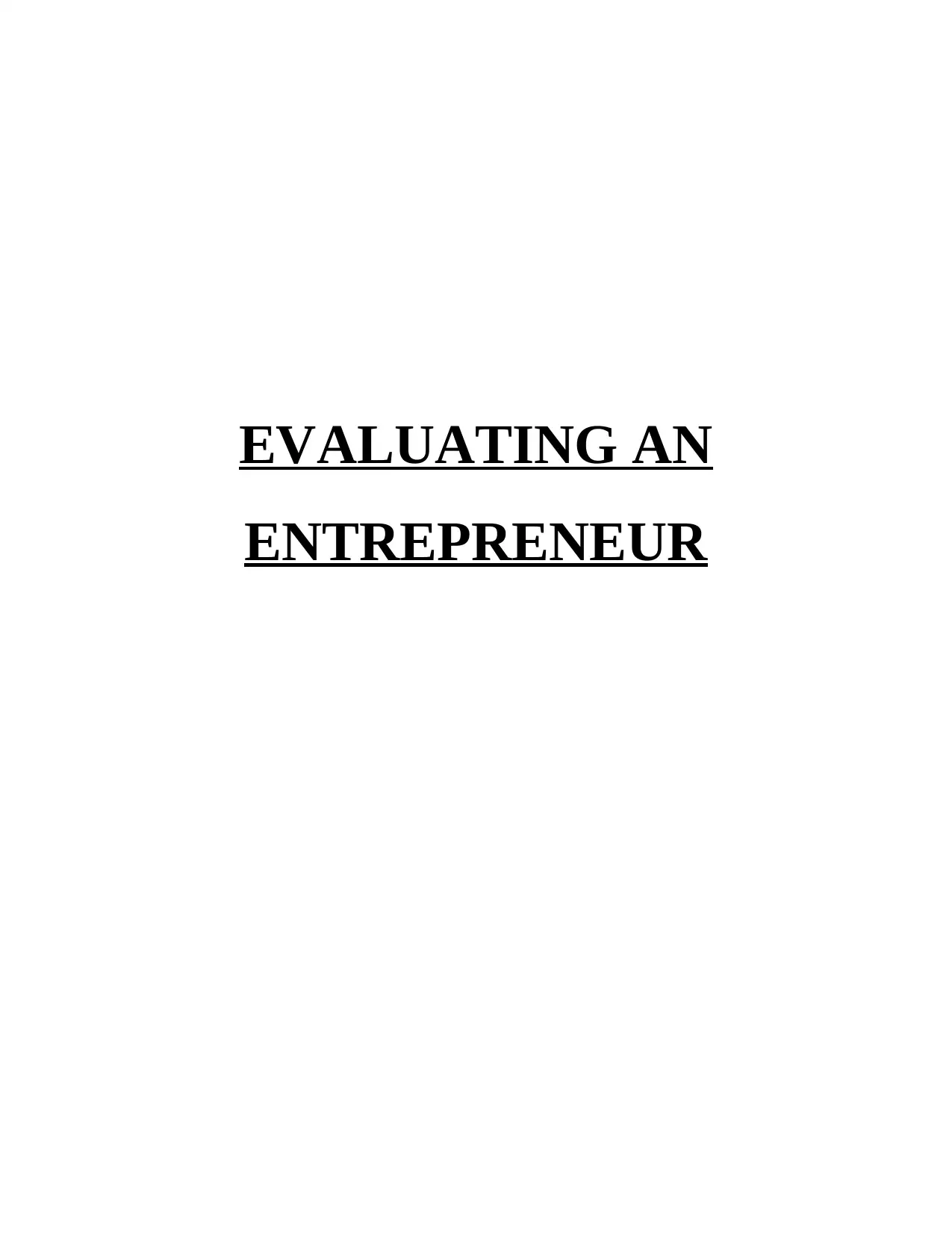
EVALUATING AN
ENTREPRENEUR
ENTREPRENEUR
Paraphrase This Document
Need a fresh take? Get an instant paraphrase of this document with our AI Paraphraser
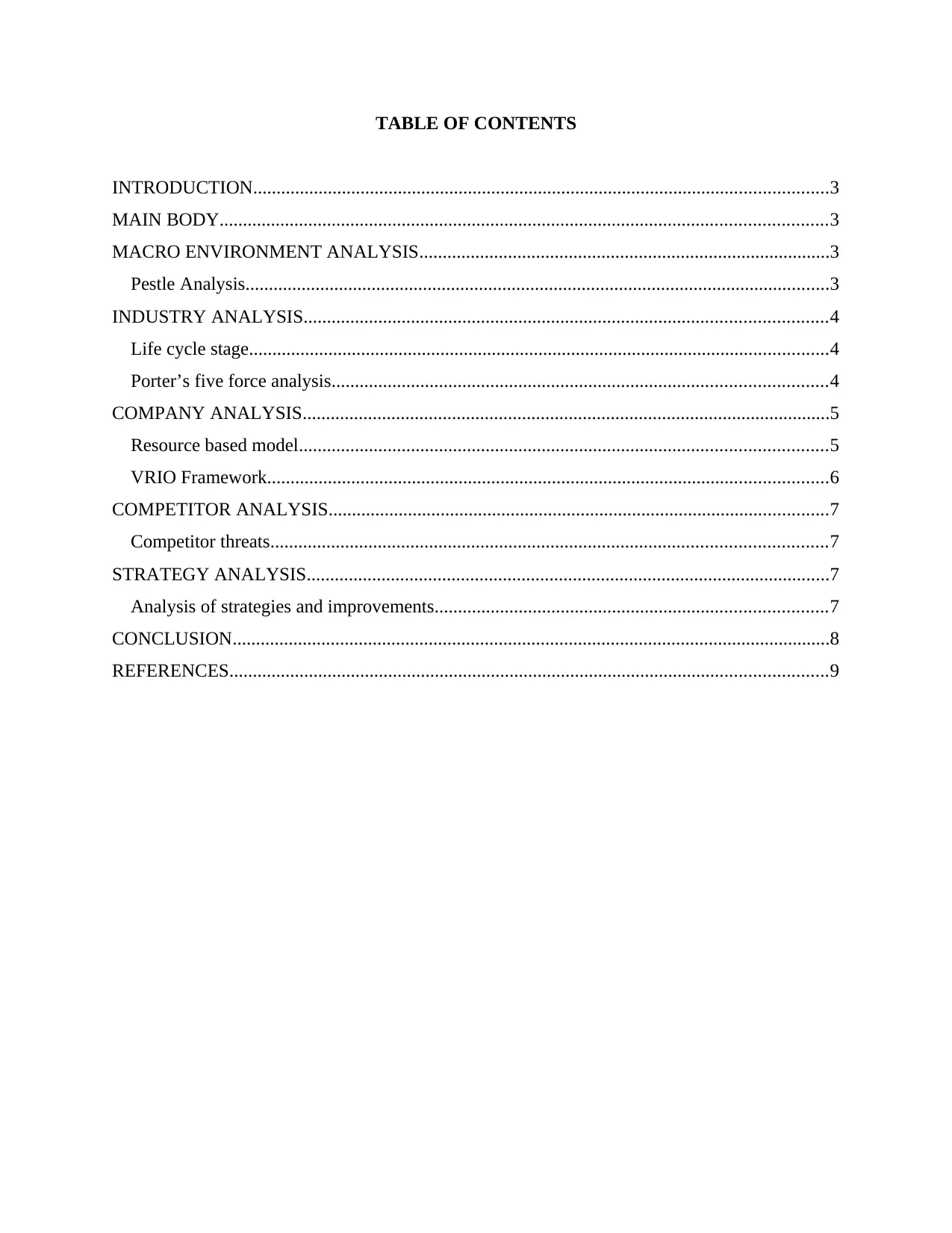
TABLE OF CONTENTS
INTRODUCTION...........................................................................................................................3
MAIN BODY..................................................................................................................................3
MACRO ENVIRONMENT ANALYSIS........................................................................................3
Pestle Analysis.............................................................................................................................3
INDUSTRY ANALYSIS................................................................................................................4
Life cycle stage............................................................................................................................4
Porter’s five force analysis..........................................................................................................4
COMPANY ANALYSIS.................................................................................................................5
Resource based model.................................................................................................................5
VRIO Framework........................................................................................................................6
COMPETITOR ANALYSIS...........................................................................................................7
Competitor threats.......................................................................................................................7
STRATEGY ANALYSIS................................................................................................................7
Analysis of strategies and improvements....................................................................................7
CONCLUSION................................................................................................................................8
REFERENCES................................................................................................................................9
INTRODUCTION...........................................................................................................................3
MAIN BODY..................................................................................................................................3
MACRO ENVIRONMENT ANALYSIS........................................................................................3
Pestle Analysis.............................................................................................................................3
INDUSTRY ANALYSIS................................................................................................................4
Life cycle stage............................................................................................................................4
Porter’s five force analysis..........................................................................................................4
COMPANY ANALYSIS.................................................................................................................5
Resource based model.................................................................................................................5
VRIO Framework........................................................................................................................6
COMPETITOR ANALYSIS...........................................................................................................7
Competitor threats.......................................................................................................................7
STRATEGY ANALYSIS................................................................................................................7
Analysis of strategies and improvements....................................................................................7
CONCLUSION................................................................................................................................8
REFERENCES................................................................................................................................9
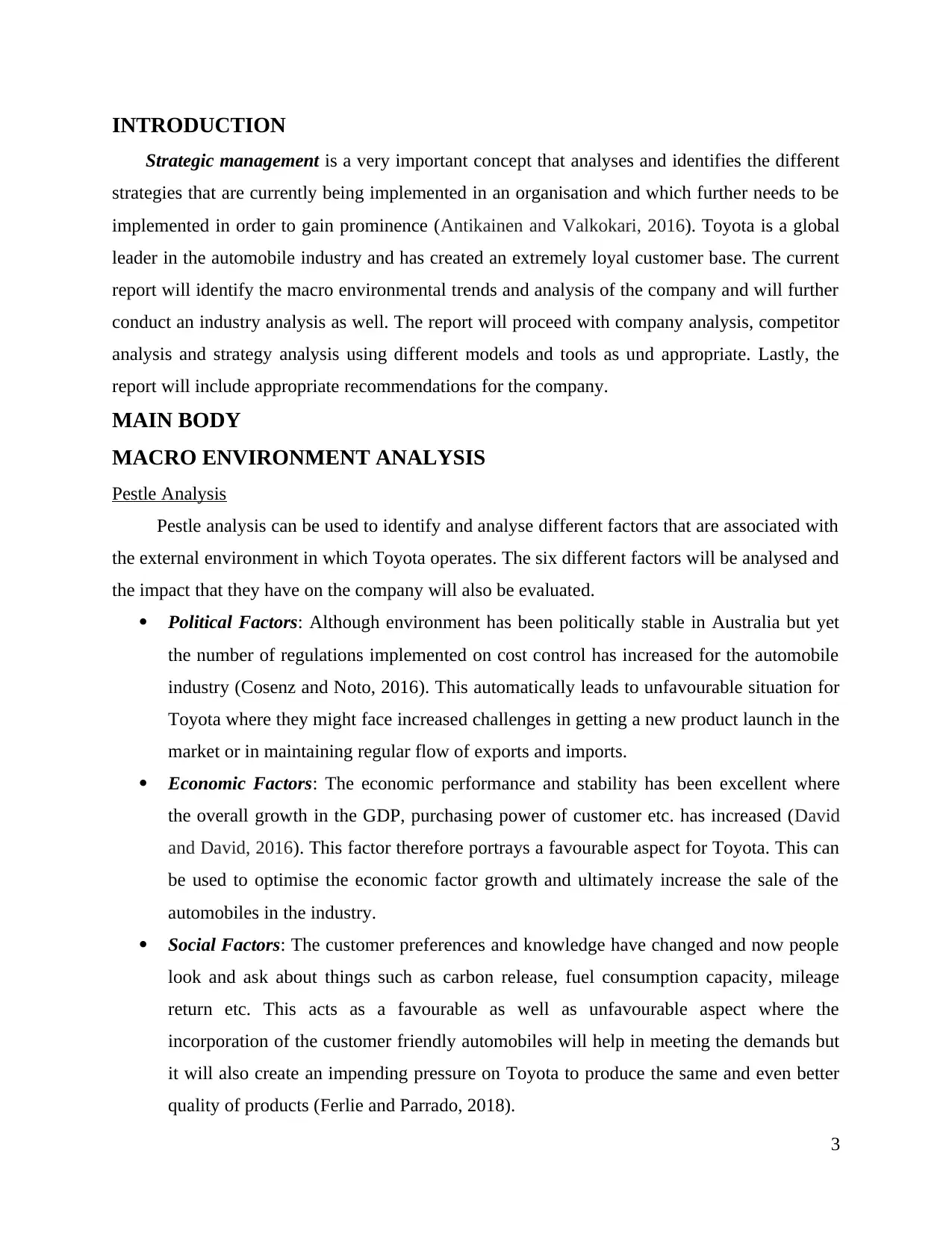
INTRODUCTION
Strategic management is a very important concept that analyses and identifies the different
strategies that are currently being implemented in an organisation and which further needs to be
implemented in order to gain prominence (Antikainen and Valkokari, 2016). Toyota is a global
leader in the automobile industry and has created an extremely loyal customer base. The current
report will identify the macro environmental trends and analysis of the company and will further
conduct an industry analysis as well. The report will proceed with company analysis, competitor
analysis and strategy analysis using different models and tools as und appropriate. Lastly, the
report will include appropriate recommendations for the company.
MAIN BODY
MACRO ENVIRONMENT ANALYSIS
Pestle Analysis
Pestle analysis can be used to identify and analyse different factors that are associated with
the external environment in which Toyota operates. The six different factors will be analysed and
the impact that they have on the company will also be evaluated.
Political Factors: Although environment has been politically stable in Australia but yet
the number of regulations implemented on cost control has increased for the automobile
industry (Cosenz and Noto, 2016). This automatically leads to unfavourable situation for
Toyota where they might face increased challenges in getting a new product launch in the
market or in maintaining regular flow of exports and imports.
Economic Factors: The economic performance and stability has been excellent where
the overall growth in the GDP, purchasing power of customer etc. has increased (David
and David, 2016). This factor therefore portrays a favourable aspect for Toyota. This can
be used to optimise the economic factor growth and ultimately increase the sale of the
automobiles in the industry.
Social Factors: The customer preferences and knowledge have changed and now people
look and ask about things such as carbon release, fuel consumption capacity, mileage
return etc. This acts as a favourable as well as unfavourable aspect where the
incorporation of the customer friendly automobiles will help in meeting the demands but
it will also create an impending pressure on Toyota to produce the same and even better
quality of products (Ferlie and Parrado, 2018).
3
Strategic management is a very important concept that analyses and identifies the different
strategies that are currently being implemented in an organisation and which further needs to be
implemented in order to gain prominence (Antikainen and Valkokari, 2016). Toyota is a global
leader in the automobile industry and has created an extremely loyal customer base. The current
report will identify the macro environmental trends and analysis of the company and will further
conduct an industry analysis as well. The report will proceed with company analysis, competitor
analysis and strategy analysis using different models and tools as und appropriate. Lastly, the
report will include appropriate recommendations for the company.
MAIN BODY
MACRO ENVIRONMENT ANALYSIS
Pestle Analysis
Pestle analysis can be used to identify and analyse different factors that are associated with
the external environment in which Toyota operates. The six different factors will be analysed and
the impact that they have on the company will also be evaluated.
Political Factors: Although environment has been politically stable in Australia but yet
the number of regulations implemented on cost control has increased for the automobile
industry (Cosenz and Noto, 2016). This automatically leads to unfavourable situation for
Toyota where they might face increased challenges in getting a new product launch in the
market or in maintaining regular flow of exports and imports.
Economic Factors: The economic performance and stability has been excellent where
the overall growth in the GDP, purchasing power of customer etc. has increased (David
and David, 2016). This factor therefore portrays a favourable aspect for Toyota. This can
be used to optimise the economic factor growth and ultimately increase the sale of the
automobiles in the industry.
Social Factors: The customer preferences and knowledge have changed and now people
look and ask about things such as carbon release, fuel consumption capacity, mileage
return etc. This acts as a favourable as well as unfavourable aspect where the
incorporation of the customer friendly automobiles will help in meeting the demands but
it will also create an impending pressure on Toyota to produce the same and even better
quality of products (Ferlie and Parrado, 2018).
3
⊘ This is a preview!⊘
Do you want full access?
Subscribe today to unlock all pages.

Trusted by 1+ million students worldwide
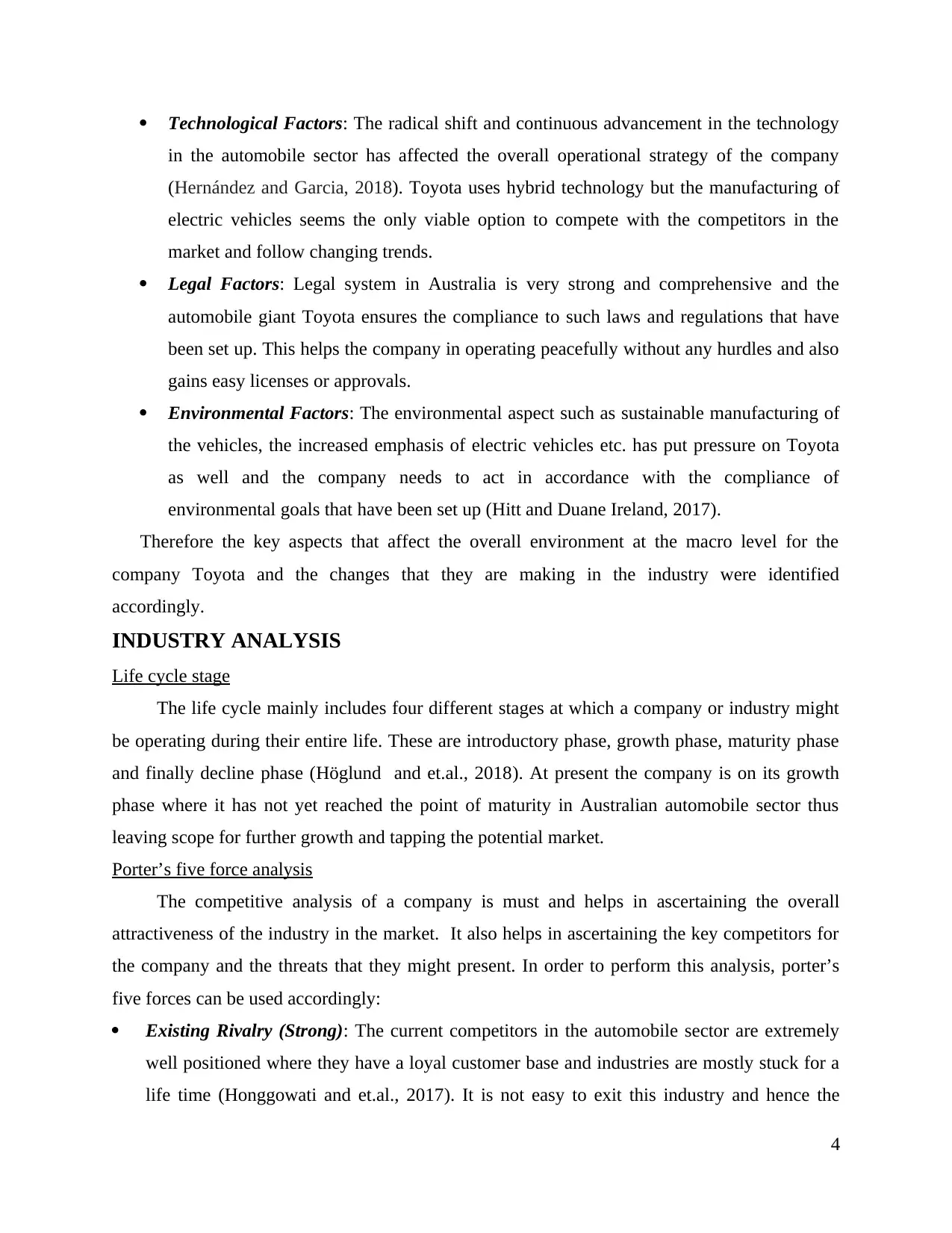
Technological Factors: The radical shift and continuous advancement in the technology
in the automobile sector has affected the overall operational strategy of the company
(Hernández and Garcia, 2018). Toyota uses hybrid technology but the manufacturing of
electric vehicles seems the only viable option to compete with the competitors in the
market and follow changing trends.
Legal Factors: Legal system in Australia is very strong and comprehensive and the
automobile giant Toyota ensures the compliance to such laws and regulations that have
been set up. This helps the company in operating peacefully without any hurdles and also
gains easy licenses or approvals.
Environmental Factors: The environmental aspect such as sustainable manufacturing of
the vehicles, the increased emphasis of electric vehicles etc. has put pressure on Toyota
as well and the company needs to act in accordance with the compliance of
environmental goals that have been set up (Hitt and Duane Ireland, 2017).
Therefore the key aspects that affect the overall environment at the macro level for the
company Toyota and the changes that they are making in the industry were identified
accordingly.
INDUSTRY ANALYSIS
Life cycle stage
The life cycle mainly includes four different stages at which a company or industry might
be operating during their entire life. These are introductory phase, growth phase, maturity phase
and finally decline phase (Höglund and et.al., 2018). At present the company is on its growth
phase where it has not yet reached the point of maturity in Australian automobile sector thus
leaving scope for further growth and tapping the potential market.
Porter’s five force analysis
The competitive analysis of a company is must and helps in ascertaining the overall
attractiveness of the industry in the market. It also helps in ascertaining the key competitors for
the company and the threats that they might present. In order to perform this analysis, porter’s
five forces can be used accordingly:
Existing Rivalry (Strong): The current competitors in the automobile sector are extremely
well positioned where they have a loyal customer base and industries are mostly stuck for a
life time (Honggowati and et.al., 2017). It is not easy to exit this industry and hence the
4
in the automobile sector has affected the overall operational strategy of the company
(Hernández and Garcia, 2018). Toyota uses hybrid technology but the manufacturing of
electric vehicles seems the only viable option to compete with the competitors in the
market and follow changing trends.
Legal Factors: Legal system in Australia is very strong and comprehensive and the
automobile giant Toyota ensures the compliance to such laws and regulations that have
been set up. This helps the company in operating peacefully without any hurdles and also
gains easy licenses or approvals.
Environmental Factors: The environmental aspect such as sustainable manufacturing of
the vehicles, the increased emphasis of electric vehicles etc. has put pressure on Toyota
as well and the company needs to act in accordance with the compliance of
environmental goals that have been set up (Hitt and Duane Ireland, 2017).
Therefore the key aspects that affect the overall environment at the macro level for the
company Toyota and the changes that they are making in the industry were identified
accordingly.
INDUSTRY ANALYSIS
Life cycle stage
The life cycle mainly includes four different stages at which a company or industry might
be operating during their entire life. These are introductory phase, growth phase, maturity phase
and finally decline phase (Höglund and et.al., 2018). At present the company is on its growth
phase where it has not yet reached the point of maturity in Australian automobile sector thus
leaving scope for further growth and tapping the potential market.
Porter’s five force analysis
The competitive analysis of a company is must and helps in ascertaining the overall
attractiveness of the industry in the market. It also helps in ascertaining the key competitors for
the company and the threats that they might present. In order to perform this analysis, porter’s
five forces can be used accordingly:
Existing Rivalry (Strong): The current competitors in the automobile sector are extremely
well positioned where they have a loyal customer base and industries are mostly stuck for a
life time (Honggowati and et.al., 2017). It is not easy to exit this industry and hence the
4
Paraphrase This Document
Need a fresh take? Get an instant paraphrase of this document with our AI Paraphraser
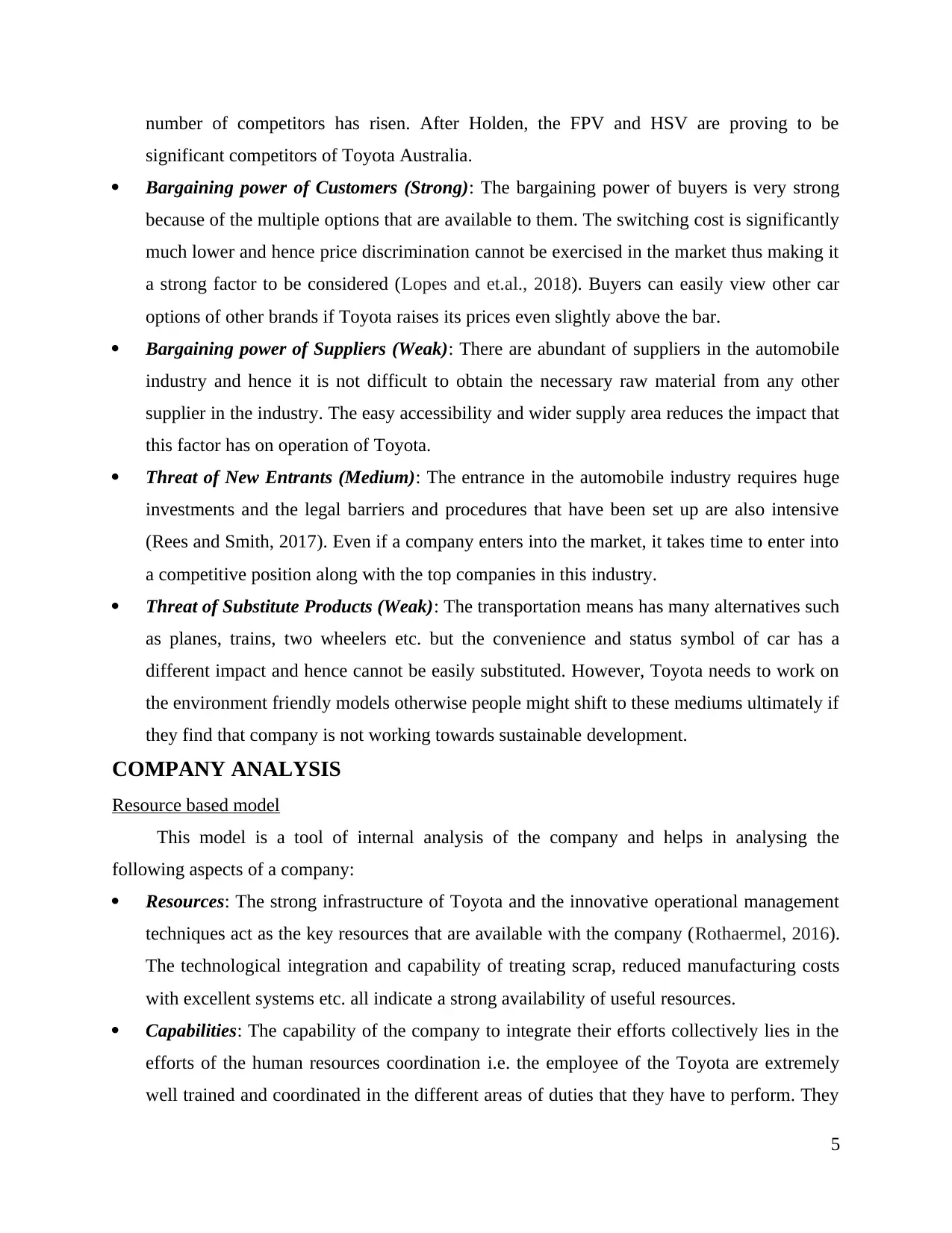
number of competitors has risen. After Holden, the FPV and HSV are proving to be
significant competitors of Toyota Australia.
Bargaining power of Customers (Strong): The bargaining power of buyers is very strong
because of the multiple options that are available to them. The switching cost is significantly
much lower and hence price discrimination cannot be exercised in the market thus making it
a strong factor to be considered (Lopes and et.al., 2018). Buyers can easily view other car
options of other brands if Toyota raises its prices even slightly above the bar.
Bargaining power of Suppliers (Weak): There are abundant of suppliers in the automobile
industry and hence it is not difficult to obtain the necessary raw material from any other
supplier in the industry. The easy accessibility and wider supply area reduces the impact that
this factor has on operation of Toyota.
Threat of New Entrants (Medium): The entrance in the automobile industry requires huge
investments and the legal barriers and procedures that have been set up are also intensive
(Rees and Smith, 2017). Even if a company enters into the market, it takes time to enter into
a competitive position along with the top companies in this industry.
Threat of Substitute Products (Weak): The transportation means has many alternatives such
as planes, trains, two wheelers etc. but the convenience and status symbol of car has a
different impact and hence cannot be easily substituted. However, Toyota needs to work on
the environment friendly models otherwise people might shift to these mediums ultimately if
they find that company is not working towards sustainable development.
COMPANY ANALYSIS
Resource based model
This model is a tool of internal analysis of the company and helps in analysing the
following aspects of a company:
Resources: The strong infrastructure of Toyota and the innovative operational management
techniques act as the key resources that are available with the company (Rothaermel, 2016).
The technological integration and capability of treating scrap, reduced manufacturing costs
with excellent systems etc. all indicate a strong availability of useful resources.
Capabilities: The capability of the company to integrate their efforts collectively lies in the
efforts of the human resources coordination i.e. the employee of the Toyota are extremely
well trained and coordinated in the different areas of duties that they have to perform. They
5
significant competitors of Toyota Australia.
Bargaining power of Customers (Strong): The bargaining power of buyers is very strong
because of the multiple options that are available to them. The switching cost is significantly
much lower and hence price discrimination cannot be exercised in the market thus making it
a strong factor to be considered (Lopes and et.al., 2018). Buyers can easily view other car
options of other brands if Toyota raises its prices even slightly above the bar.
Bargaining power of Suppliers (Weak): There are abundant of suppliers in the automobile
industry and hence it is not difficult to obtain the necessary raw material from any other
supplier in the industry. The easy accessibility and wider supply area reduces the impact that
this factor has on operation of Toyota.
Threat of New Entrants (Medium): The entrance in the automobile industry requires huge
investments and the legal barriers and procedures that have been set up are also intensive
(Rees and Smith, 2017). Even if a company enters into the market, it takes time to enter into
a competitive position along with the top companies in this industry.
Threat of Substitute Products (Weak): The transportation means has many alternatives such
as planes, trains, two wheelers etc. but the convenience and status symbol of car has a
different impact and hence cannot be easily substituted. However, Toyota needs to work on
the environment friendly models otherwise people might shift to these mediums ultimately if
they find that company is not working towards sustainable development.
COMPANY ANALYSIS
Resource based model
This model is a tool of internal analysis of the company and helps in analysing the
following aspects of a company:
Resources: The strong infrastructure of Toyota and the innovative operational management
techniques act as the key resources that are available with the company (Rothaermel, 2016).
The technological integration and capability of treating scrap, reduced manufacturing costs
with excellent systems etc. all indicate a strong availability of useful resources.
Capabilities: The capability of the company to integrate their efforts collectively lies in the
efforts of the human resources coordination i.e. the employee of the Toyota are extremely
well trained and coordinated in the different areas of duties that they have to perform. They
5
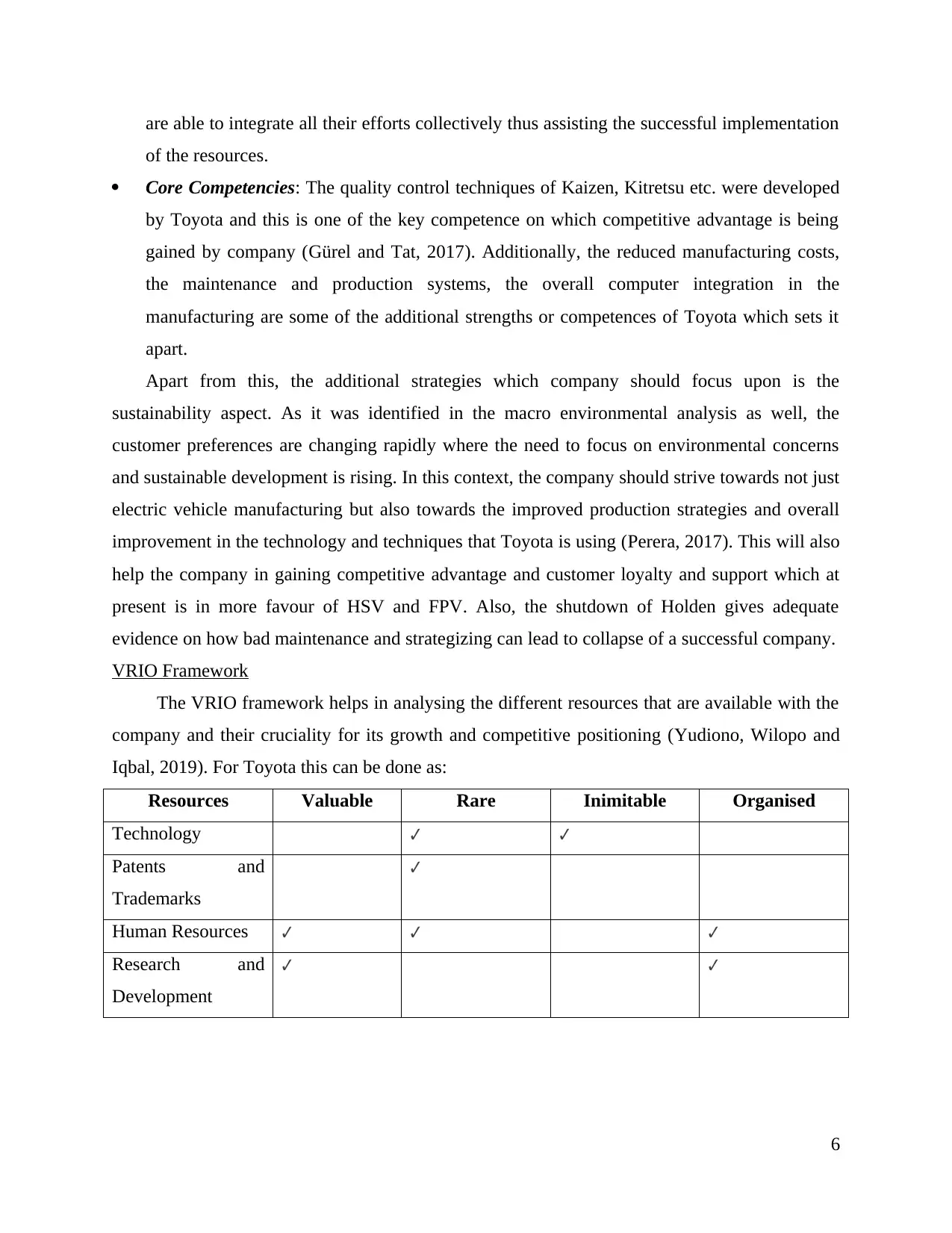
are able to integrate all their efforts collectively thus assisting the successful implementation
of the resources.
Core Competencies: The quality control techniques of Kaizen, Kitretsu etc. were developed
by Toyota and this is one of the key competence on which competitive advantage is being
gained by company (Gürel and Tat, 2017). Additionally, the reduced manufacturing costs,
the maintenance and production systems, the overall computer integration in the
manufacturing are some of the additional strengths or competences of Toyota which sets it
apart.
Apart from this, the additional strategies which company should focus upon is the
sustainability aspect. As it was identified in the macro environmental analysis as well, the
customer preferences are changing rapidly where the need to focus on environmental concerns
and sustainable development is rising. In this context, the company should strive towards not just
electric vehicle manufacturing but also towards the improved production strategies and overall
improvement in the technology and techniques that Toyota is using (Perera, 2017). This will also
help the company in gaining competitive advantage and customer loyalty and support which at
present is in more favour of HSV and FPV. Also, the shutdown of Holden gives adequate
evidence on how bad maintenance and strategizing can lead to collapse of a successful company.
VRIO Framework
The VRIO framework helps in analysing the different resources that are available with the
company and their cruciality for its growth and competitive positioning (Yudiono, Wilopo and
Iqbal, 2019). For Toyota this can be done as:
Resources Valuable Rare Inimitable Organised
Technology ✔ ✔
Patents and
Trademarks
✔
Human Resources ✔ ✔ ✔
Research and
Development
✔ ✔
6
of the resources.
Core Competencies: The quality control techniques of Kaizen, Kitretsu etc. were developed
by Toyota and this is one of the key competence on which competitive advantage is being
gained by company (Gürel and Tat, 2017). Additionally, the reduced manufacturing costs,
the maintenance and production systems, the overall computer integration in the
manufacturing are some of the additional strengths or competences of Toyota which sets it
apart.
Apart from this, the additional strategies which company should focus upon is the
sustainability aspect. As it was identified in the macro environmental analysis as well, the
customer preferences are changing rapidly where the need to focus on environmental concerns
and sustainable development is rising. In this context, the company should strive towards not just
electric vehicle manufacturing but also towards the improved production strategies and overall
improvement in the technology and techniques that Toyota is using (Perera, 2017). This will also
help the company in gaining competitive advantage and customer loyalty and support which at
present is in more favour of HSV and FPV. Also, the shutdown of Holden gives adequate
evidence on how bad maintenance and strategizing can lead to collapse of a successful company.
VRIO Framework
The VRIO framework helps in analysing the different resources that are available with the
company and their cruciality for its growth and competitive positioning (Yudiono, Wilopo and
Iqbal, 2019). For Toyota this can be done as:
Resources Valuable Rare Inimitable Organised
Technology ✔ ✔
Patents and
Trademarks
✔
Human Resources ✔ ✔ ✔
Research and
Development
✔ ✔
6
⊘ This is a preview!⊘
Do you want full access?
Subscribe today to unlock all pages.

Trusted by 1+ million students worldwide
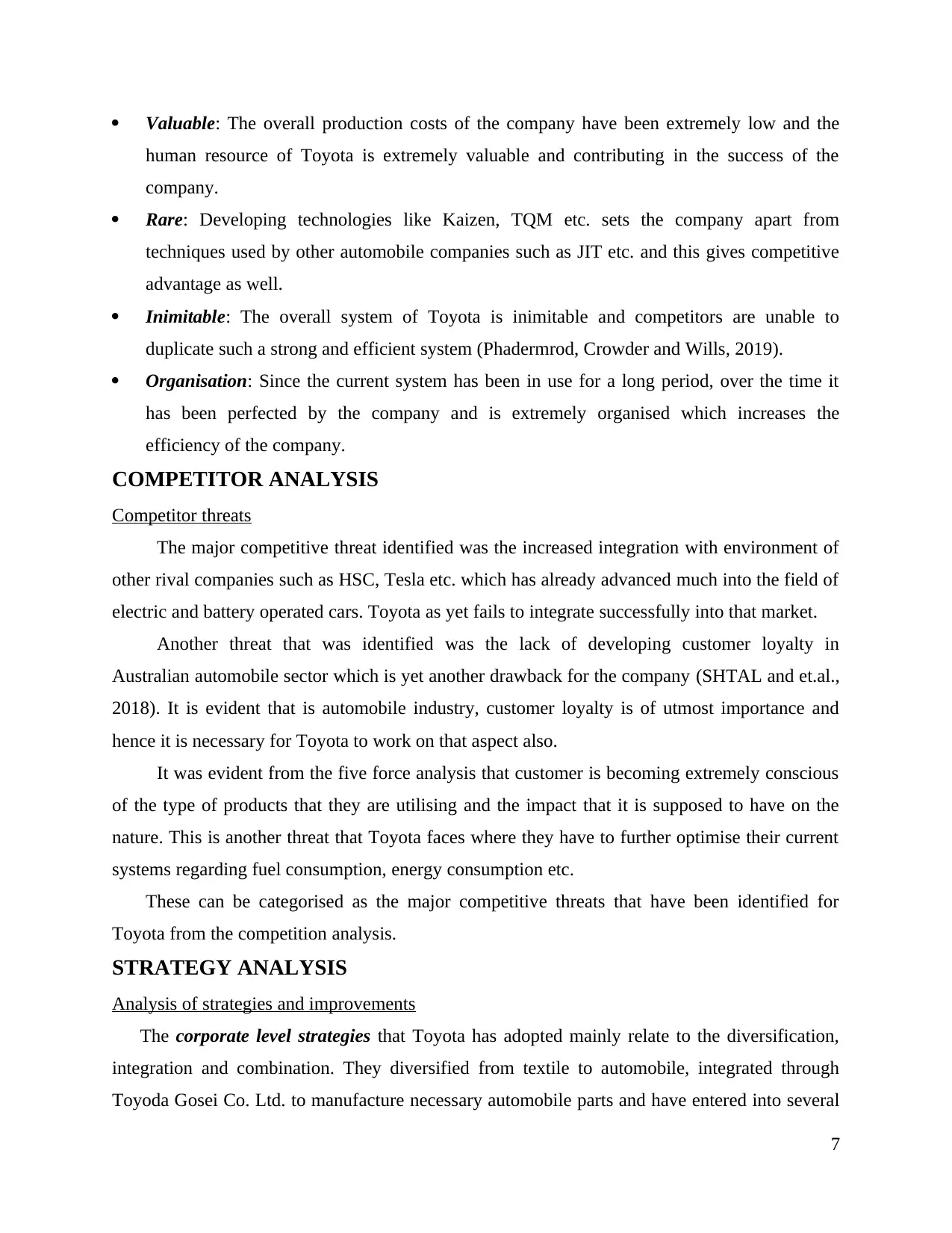
Valuable: The overall production costs of the company have been extremely low and the
human resource of Toyota is extremely valuable and contributing in the success of the
company.
Rare: Developing technologies like Kaizen, TQM etc. sets the company apart from
techniques used by other automobile companies such as JIT etc. and this gives competitive
advantage as well.
Inimitable: The overall system of Toyota is inimitable and competitors are unable to
duplicate such a strong and efficient system (Phadermrod, Crowder and Wills, 2019).
Organisation: Since the current system has been in use for a long period, over the time it
has been perfected by the company and is extremely organised which increases the
efficiency of the company.
COMPETITOR ANALYSIS
Competitor threats
The major competitive threat identified was the increased integration with environment of
other rival companies such as HSC, Tesla etc. which has already advanced much into the field of
electric and battery operated cars. Toyota as yet fails to integrate successfully into that market.
Another threat that was identified was the lack of developing customer loyalty in
Australian automobile sector which is yet another drawback for the company (SHTAL and et.al.,
2018). It is evident that is automobile industry, customer loyalty is of utmost importance and
hence it is necessary for Toyota to work on that aspect also.
It was evident from the five force analysis that customer is becoming extremely conscious
of the type of products that they are utilising and the impact that it is supposed to have on the
nature. This is another threat that Toyota faces where they have to further optimise their current
systems regarding fuel consumption, energy consumption etc.
These can be categorised as the major competitive threats that have been identified for
Toyota from the competition analysis.
STRATEGY ANALYSIS
Analysis of strategies and improvements
The corporate level strategies that Toyota has adopted mainly relate to the diversification,
integration and combination. They diversified from textile to automobile, integrated through
Toyoda Gosei Co. Ltd. to manufacture necessary automobile parts and have entered into several
7
human resource of Toyota is extremely valuable and contributing in the success of the
company.
Rare: Developing technologies like Kaizen, TQM etc. sets the company apart from
techniques used by other automobile companies such as JIT etc. and this gives competitive
advantage as well.
Inimitable: The overall system of Toyota is inimitable and competitors are unable to
duplicate such a strong and efficient system (Phadermrod, Crowder and Wills, 2019).
Organisation: Since the current system has been in use for a long period, over the time it
has been perfected by the company and is extremely organised which increases the
efficiency of the company.
COMPETITOR ANALYSIS
Competitor threats
The major competitive threat identified was the increased integration with environment of
other rival companies such as HSC, Tesla etc. which has already advanced much into the field of
electric and battery operated cars. Toyota as yet fails to integrate successfully into that market.
Another threat that was identified was the lack of developing customer loyalty in
Australian automobile sector which is yet another drawback for the company (SHTAL and et.al.,
2018). It is evident that is automobile industry, customer loyalty is of utmost importance and
hence it is necessary for Toyota to work on that aspect also.
It was evident from the five force analysis that customer is becoming extremely conscious
of the type of products that they are utilising and the impact that it is supposed to have on the
nature. This is another threat that Toyota faces where they have to further optimise their current
systems regarding fuel consumption, energy consumption etc.
These can be categorised as the major competitive threats that have been identified for
Toyota from the competition analysis.
STRATEGY ANALYSIS
Analysis of strategies and improvements
The corporate level strategies that Toyota has adopted mainly relate to the diversification,
integration and combination. They diversified from textile to automobile, integrated through
Toyoda Gosei Co. Ltd. to manufacture necessary automobile parts and have entered into several
7
Paraphrase This Document
Need a fresh take? Get an instant paraphrase of this document with our AI Paraphraser
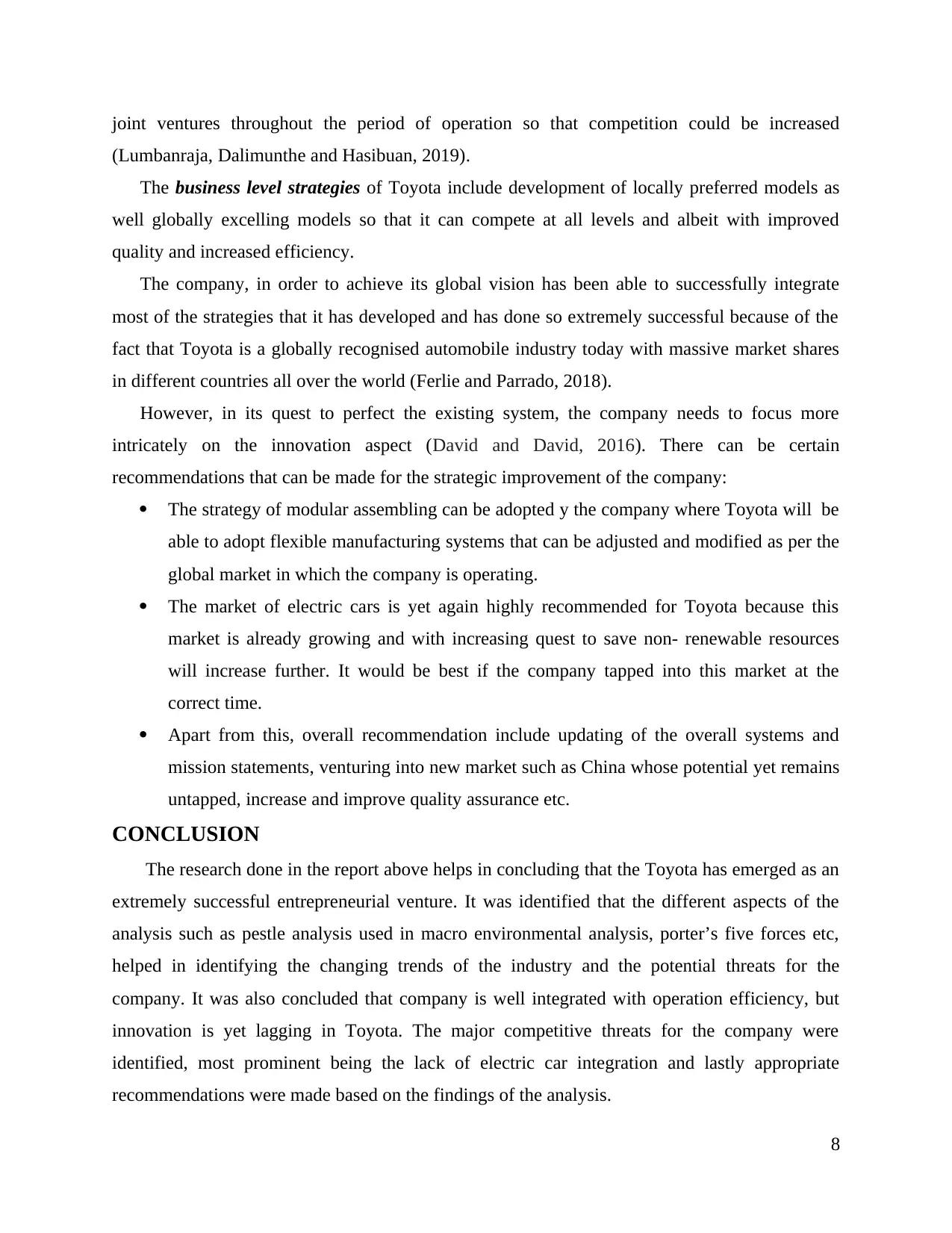
joint ventures throughout the period of operation so that competition could be increased
(Lumbanraja, Dalimunthe and Hasibuan, 2019).
The business level strategies of Toyota include development of locally preferred models as
well globally excelling models so that it can compete at all levels and albeit with improved
quality and increased efficiency.
The company, in order to achieve its global vision has been able to successfully integrate
most of the strategies that it has developed and has done so extremely successful because of the
fact that Toyota is a globally recognised automobile industry today with massive market shares
in different countries all over the world (Ferlie and Parrado, 2018).
However, in its quest to perfect the existing system, the company needs to focus more
intricately on the innovation aspect (David and David, 2016). There can be certain
recommendations that can be made for the strategic improvement of the company:
The strategy of modular assembling can be adopted y the company where Toyota will be
able to adopt flexible manufacturing systems that can be adjusted and modified as per the
global market in which the company is operating.
The market of electric cars is yet again highly recommended for Toyota because this
market is already growing and with increasing quest to save non- renewable resources
will increase further. It would be best if the company tapped into this market at the
correct time.
Apart from this, overall recommendation include updating of the overall systems and
mission statements, venturing into new market such as China whose potential yet remains
untapped, increase and improve quality assurance etc.
CONCLUSION
The research done in the report above helps in concluding that the Toyota has emerged as an
extremely successful entrepreneurial venture. It was identified that the different aspects of the
analysis such as pestle analysis used in macro environmental analysis, porter’s five forces etc,
helped in identifying the changing trends of the industry and the potential threats for the
company. It was also concluded that company is well integrated with operation efficiency, but
innovation is yet lagging in Toyota. The major competitive threats for the company were
identified, most prominent being the lack of electric car integration and lastly appropriate
recommendations were made based on the findings of the analysis.
8
(Lumbanraja, Dalimunthe and Hasibuan, 2019).
The business level strategies of Toyota include development of locally preferred models as
well globally excelling models so that it can compete at all levels and albeit with improved
quality and increased efficiency.
The company, in order to achieve its global vision has been able to successfully integrate
most of the strategies that it has developed and has done so extremely successful because of the
fact that Toyota is a globally recognised automobile industry today with massive market shares
in different countries all over the world (Ferlie and Parrado, 2018).
However, in its quest to perfect the existing system, the company needs to focus more
intricately on the innovation aspect (David and David, 2016). There can be certain
recommendations that can be made for the strategic improvement of the company:
The strategy of modular assembling can be adopted y the company where Toyota will be
able to adopt flexible manufacturing systems that can be adjusted and modified as per the
global market in which the company is operating.
The market of electric cars is yet again highly recommended for Toyota because this
market is already growing and with increasing quest to save non- renewable resources
will increase further. It would be best if the company tapped into this market at the
correct time.
Apart from this, overall recommendation include updating of the overall systems and
mission statements, venturing into new market such as China whose potential yet remains
untapped, increase and improve quality assurance etc.
CONCLUSION
The research done in the report above helps in concluding that the Toyota has emerged as an
extremely successful entrepreneurial venture. It was identified that the different aspects of the
analysis such as pestle analysis used in macro environmental analysis, porter’s five forces etc,
helped in identifying the changing trends of the industry and the potential threats for the
company. It was also concluded that company is well integrated with operation efficiency, but
innovation is yet lagging in Toyota. The major competitive threats for the company were
identified, most prominent being the lack of electric car integration and lastly appropriate
recommendations were made based on the findings of the analysis.
8
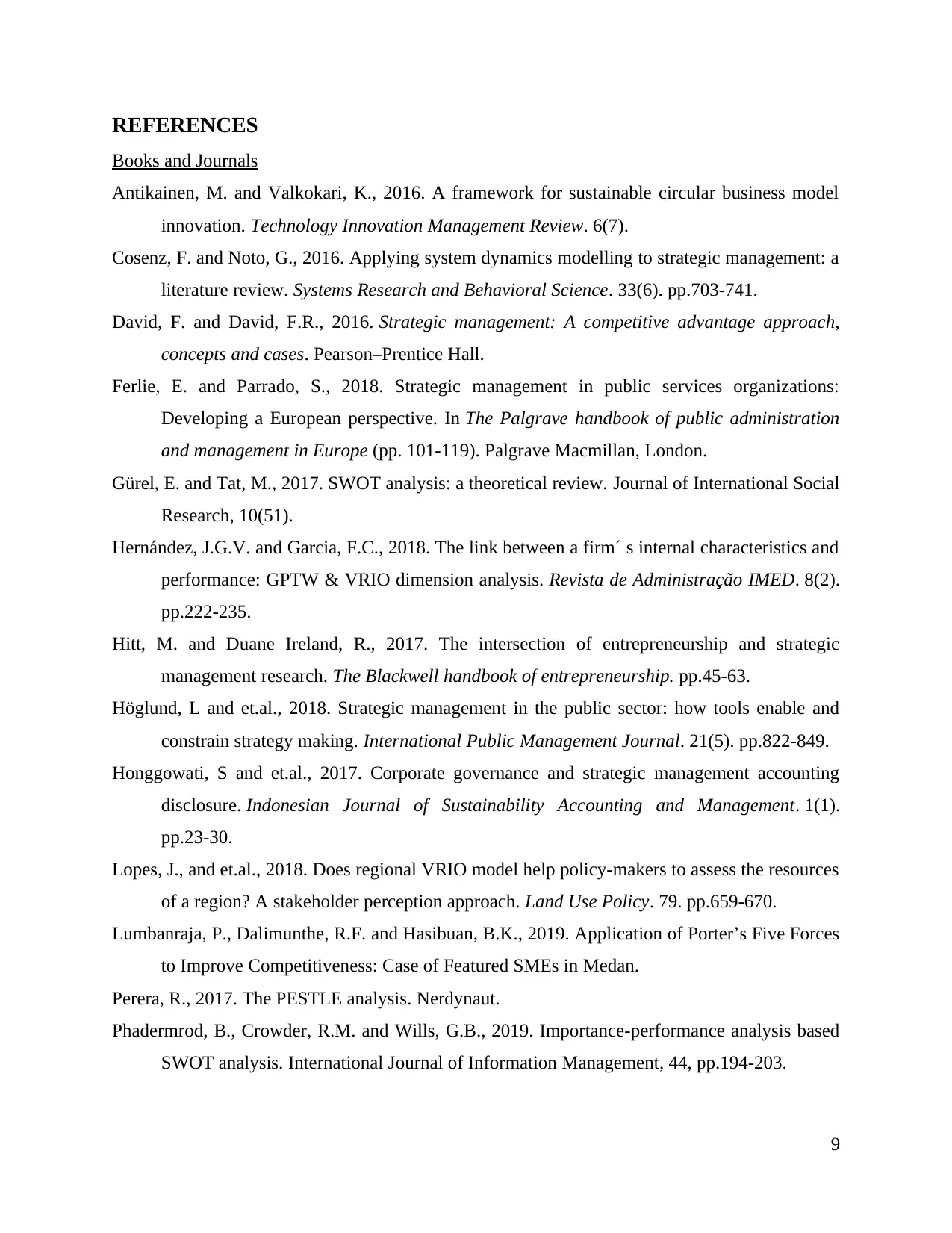
REFERENCES
Books and Journals
Antikainen, M. and Valkokari, K., 2016. A framework for sustainable circular business model
innovation. Technology Innovation Management Review. 6(7).
Cosenz, F. and Noto, G., 2016. Applying system dynamics modelling to strategic management: a
literature review. Systems Research and Behavioral Science. 33(6). pp.703-741.
David, F. and David, F.R., 2016. Strategic management: A competitive advantage approach,
concepts and cases. Pearson–Prentice Hall.
Ferlie, E. and Parrado, S., 2018. Strategic management in public services organizations:
Developing a European perspective. In The Palgrave handbook of public administration
and management in Europe (pp. 101-119). Palgrave Macmillan, London.
Gürel, E. and Tat, M., 2017. SWOT analysis: a theoretical review. Journal of International Social
Research, 10(51).
Hernández, J.G.V. and Garcia, F.C., 2018. The link between a firm´ s internal characteristics and
performance: GPTW & VRIO dimension analysis. Revista de Administração IMED. 8(2).
pp.222-235.
Hitt, M. and Duane Ireland, R., 2017. The intersection of entrepreneurship and strategic
management research. The Blackwell handbook of entrepreneurship. pp.45-63.
Höglund, L and et.al., 2018. Strategic management in the public sector: how tools enable and
constrain strategy making. International Public Management Journal. 21(5). pp.822-849.
Honggowati, S and et.al., 2017. Corporate governance and strategic management accounting
disclosure. Indonesian Journal of Sustainability Accounting and Management. 1(1).
pp.23-30.
Lopes, J., and et.al., 2018. Does regional VRIO model help policy-makers to assess the resources
of a region? A stakeholder perception approach. Land Use Policy. 79. pp.659-670.
Lumbanraja, P., Dalimunthe, R.F. and Hasibuan, B.K., 2019. Application of Porter’s Five Forces
to Improve Competitiveness: Case of Featured SMEs in Medan.
Perera, R., 2017. The PESTLE analysis. Nerdynaut.
Phadermrod, B., Crowder, R.M. and Wills, G.B., 2019. Importance-performance analysis based
SWOT analysis. International Journal of Information Management, 44, pp.194-203.
9
Books and Journals
Antikainen, M. and Valkokari, K., 2016. A framework for sustainable circular business model
innovation. Technology Innovation Management Review. 6(7).
Cosenz, F. and Noto, G., 2016. Applying system dynamics modelling to strategic management: a
literature review. Systems Research and Behavioral Science. 33(6). pp.703-741.
David, F. and David, F.R., 2016. Strategic management: A competitive advantage approach,
concepts and cases. Pearson–Prentice Hall.
Ferlie, E. and Parrado, S., 2018. Strategic management in public services organizations:
Developing a European perspective. In The Palgrave handbook of public administration
and management in Europe (pp. 101-119). Palgrave Macmillan, London.
Gürel, E. and Tat, M., 2017. SWOT analysis: a theoretical review. Journal of International Social
Research, 10(51).
Hernández, J.G.V. and Garcia, F.C., 2018. The link between a firm´ s internal characteristics and
performance: GPTW & VRIO dimension analysis. Revista de Administração IMED. 8(2).
pp.222-235.
Hitt, M. and Duane Ireland, R., 2017. The intersection of entrepreneurship and strategic
management research. The Blackwell handbook of entrepreneurship. pp.45-63.
Höglund, L and et.al., 2018. Strategic management in the public sector: how tools enable and
constrain strategy making. International Public Management Journal. 21(5). pp.822-849.
Honggowati, S and et.al., 2017. Corporate governance and strategic management accounting
disclosure. Indonesian Journal of Sustainability Accounting and Management. 1(1).
pp.23-30.
Lopes, J., and et.al., 2018. Does regional VRIO model help policy-makers to assess the resources
of a region? A stakeholder perception approach. Land Use Policy. 79. pp.659-670.
Lumbanraja, P., Dalimunthe, R.F. and Hasibuan, B.K., 2019. Application of Porter’s Five Forces
to Improve Competitiveness: Case of Featured SMEs in Medan.
Perera, R., 2017. The PESTLE analysis. Nerdynaut.
Phadermrod, B., Crowder, R.M. and Wills, G.B., 2019. Importance-performance analysis based
SWOT analysis. International Journal of Information Management, 44, pp.194-203.
9
⊘ This is a preview!⊘
Do you want full access?
Subscribe today to unlock all pages.

Trusted by 1+ million students worldwide
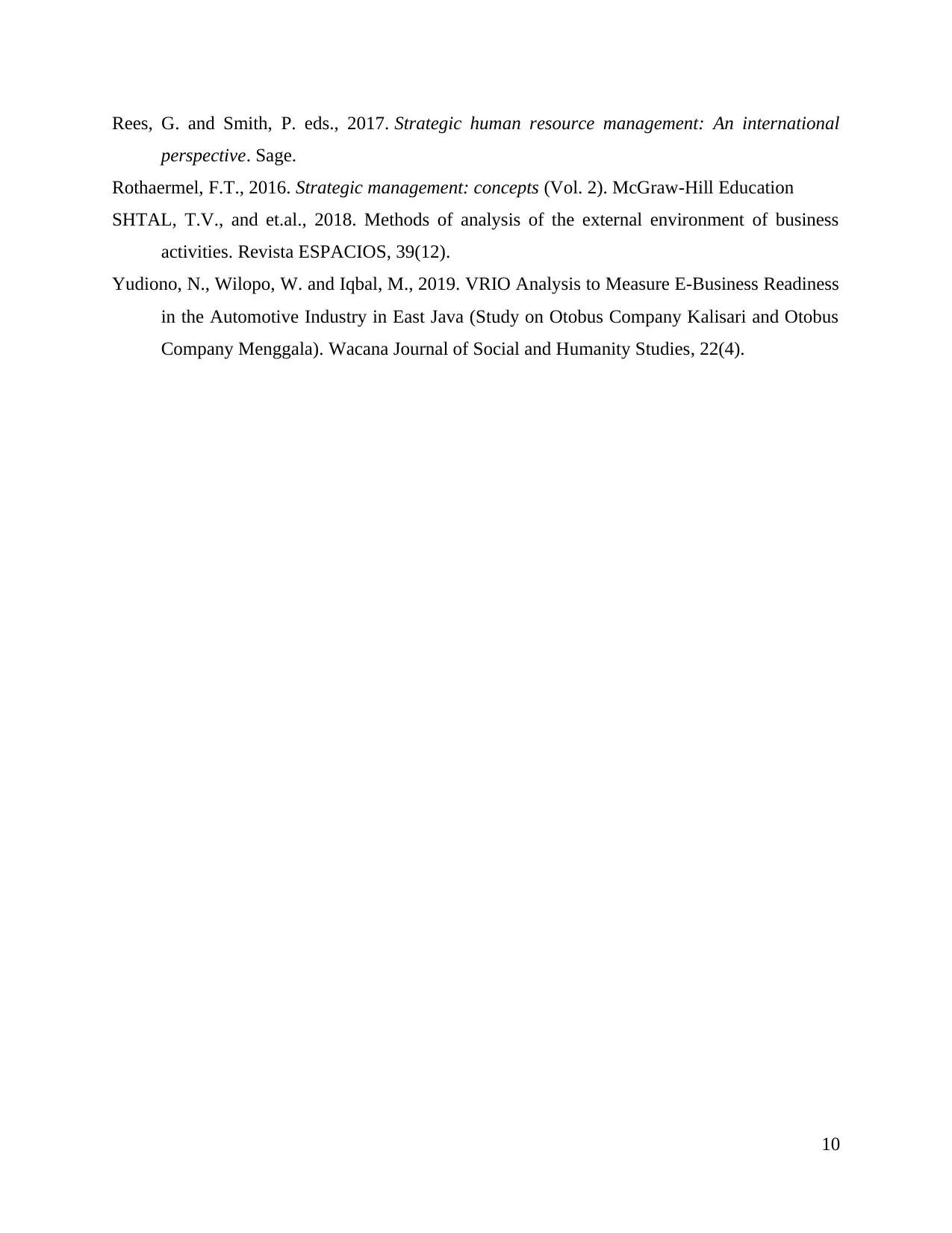
Rees, G. and Smith, P. eds., 2017. Strategic human resource management: An international
perspective. Sage.
Rothaermel, F.T., 2016. Strategic management: concepts (Vol. 2). McGraw-Hill Education
SHTAL, T.V., and et.al., 2018. Methods of analysis of the external environment of business
activities. Revista ESPACIOS, 39(12).
Yudiono, N., Wilopo, W. and Iqbal, M., 2019. VRIO Analysis to Measure E-Business Readiness
in the Automotive Industry in East Java (Study on Otobus Company Kalisari and Otobus
Company Menggala). Wacana Journal of Social and Humanity Studies, 22(4).
10
perspective. Sage.
Rothaermel, F.T., 2016. Strategic management: concepts (Vol. 2). McGraw-Hill Education
SHTAL, T.V., and et.al., 2018. Methods of analysis of the external environment of business
activities. Revista ESPACIOS, 39(12).
Yudiono, N., Wilopo, W. and Iqbal, M., 2019. VRIO Analysis to Measure E-Business Readiness
in the Automotive Industry in East Java (Study on Otobus Company Kalisari and Otobus
Company Menggala). Wacana Journal of Social and Humanity Studies, 22(4).
10
1 out of 10
Related Documents
Your All-in-One AI-Powered Toolkit for Academic Success.
+13062052269
info@desklib.com
Available 24*7 on WhatsApp / Email
![[object Object]](/_next/static/media/star-bottom.7253800d.svg)
Unlock your academic potential
Copyright © 2020–2025 A2Z Services. All Rights Reserved. Developed and managed by ZUCOL.





